Industry-Sponsored Student Capstone Projects
2023/2024
In the 2023/24 academic year, the industry capstone program was supported by 54 sponsors, more than half of which were returning, and 95 real-world projects. Over 550 students from across the College of Engineering participated. Scroll down to learn more about each project.
Boeing
Validation of Methods for Analyzing Synthetic Fuels
In 2022 - 2023, a capstone project was conducted called "Methods of Analyzing Synthetic Fuels on Board for Data Collection and Indication" led by Dr. Ben Rutz. The team identified several avenues for measuring density, height, and hydrocarbon composition; however, due to time constraints they were not able to test, validate or build upon the initial proposals. The 2023-24 student team (this year's team) will work to assess and improve upon the proposals generated by the previous team, then build and execute a system to test and validate these methods in both ground and altitude simulated environments. This student team could potentially re-use and improve upon the equipment procured during the project year 2022 - 2023. This student team will work within the following project perimeters: 1. The tolerance of all properties shall be +/- 1% 2. Capacitance and speed-of-sound methods to measure properties should not be considered as part of this study. 3. Assume no fuel additives are present per the ASTM D7566 & ASTM D1655 standards. It is ok to propose adding additives if this is supports your method of measurement and analysis. 4. Minimal weight and minimal-to-no electricity in the tank are important design and safety parameters. 5. GCxGC should not be considered as a method for measuring hydrocarbon distribution This student team will work to achieve a working system that tests and validates the proposed methods for analyzing synthetic fuels to measure: Density and Fuel Height with a stretch goal of identifying and validating a new method to determine the hydrocarbon distribution. This student will work to complete a report that identifies areas to consider to adapt this system or method for commercial economical use.
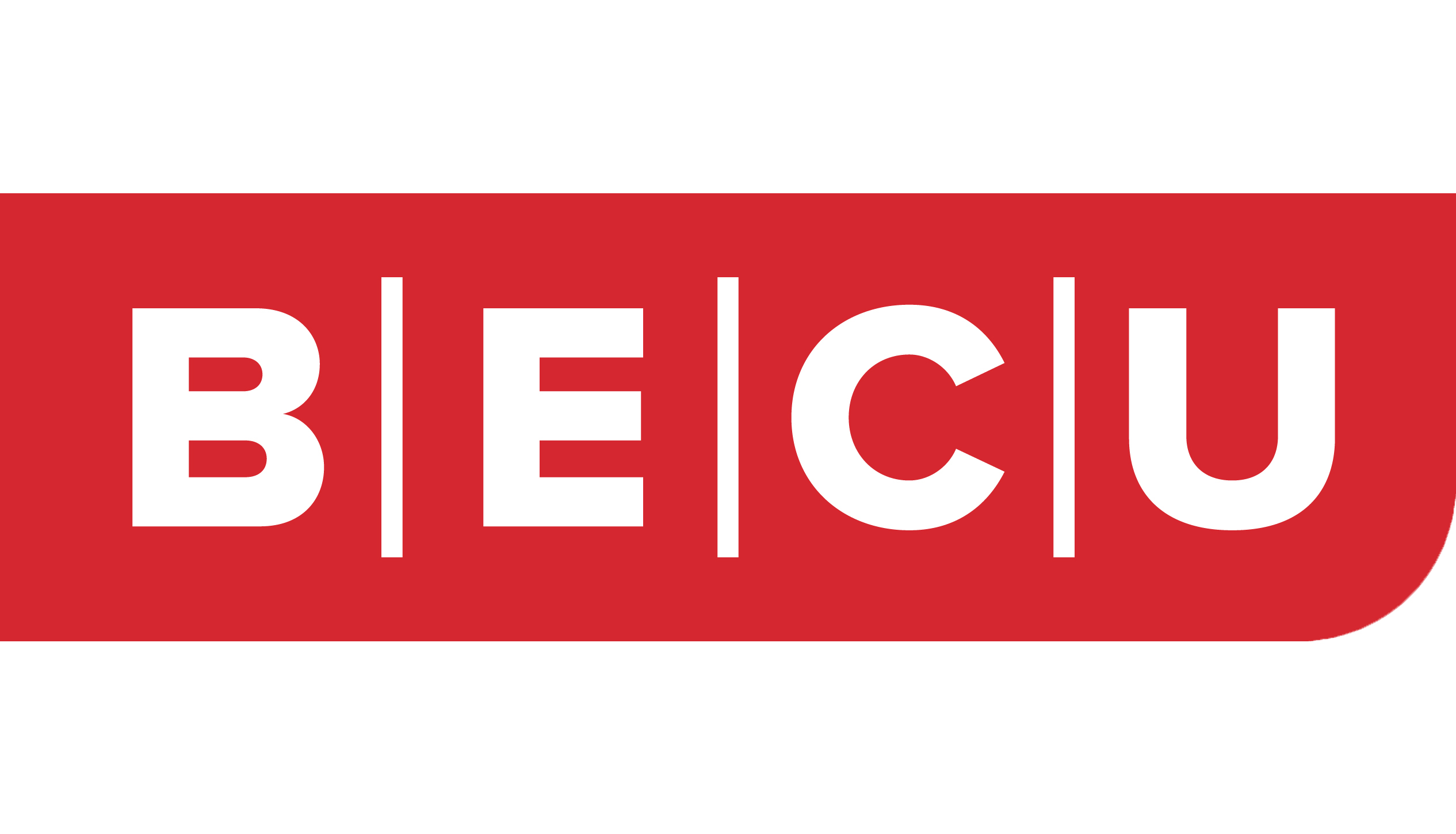
Boeing Employees' Credit Union (BECU)
PISCES Resiliency Architecture - and you thought PISCES was just a Constellation!
This student team will work to design, assemble, program, install, and test a backup site for a very large server farm that is being used to protect various small cities and municipalities from cyber criminals. The project is PISCES: Public Infrastructure Security Cyber Education System. The Public Infrastructure Security Cyber Education System (PISCES) provides qualified students with curricula and supervised experiences to act as entry-level cyber analysts. Students analyze streaming data for small communities or municipalities who may otherwise not be able to obtain cybersecurity to the extent needed. Through PISCES, a reliable high-quality pipeline is being developed to address the shortage of cyber professionals ready for the workforce. In order for PISCES to stay high-quality and reliable, this student team needs to help create a backup site away from the western part of Washington. This student team will work to design, assemble, program and test the back up ELK stack at Central Washington University in Ellensburg, WA. PISCES would provide the equipment for the students to use to install the backup site. The exact project parameters will be provided by the PISCES stakeholders and will include all the equipment necessary for the student team to assemble the backup site. The student team will work to use engineering rigor in order to make sure the site does exactly what is necessary to perform as the primary site in case of failure at the primary site in Poulsbo, WA. In addition to working to design, assemble, implement, and test the back up site, the student team will need to work to research and provide the best infrastructure path for the backup connectivity. All the resources for this project are provided by the PISCES Project. The outcome this student team is working to achieve is a complete replica of the Elk Stack that is currently located in Poulsbo, WA.
Bunafr
Development of new smoke suppression material
During coffee roasting smoke is generated. There are existing smoke suppression methods but they all have drawbacks - cost, and maintenance. Bunafr is in need of a material or combination of materials that suppress the smoke even at the darkest level of coffee roasting, that has long life before needing replacement (ideally no replacement), that is cheap to make, and that is easy to maintain. This student team will work to achieve smoke suppression required for coffee roasting at the lowest cost with the lowest cost possible and the least amount of maintenance required. Through their work, this student team would be helping to make a critical feature of coffee roasting more accessible. Smoke suppression is one of the top three features to democratize coffee roasting; today, no consumer appliance has this feature. By making this feature using inexpensive and easy-to-access materials, the student team will be helping to provide coffee roasting capability to a wider consumer base, which will transform the industry by empowering consumers to define their own cup, at lower cost. It will also empower farmers with much higher margins, and reduce the carbon footprint of coffee, all made possible by simplifying and reducing the coffee supply chain from 25 different touch points between consumer and producer to 5 touch points. The requirements of smoke suppression will be defined more solidly as the project kicks-off; however, at a high level, when someone is roasting coffee in a modern, compact apartment, with all doors and windows closed, coffee roasting anywhere from light roast to french roast should not trigger a smoke alarm. This student team will conduct testing at the most extreme level as well as most representative level in a consumer kitchen. The outcomes this student team will work to achieve include: a) smoke suppression efficacy as defined by the smoke detector in the worst case, b) durability of the smoke material, c) cost of the material, d) possibility of making the material available at the large scale. This student team will work to invent a new smoke suppression material or to combine currently existing smoke suppression materials that are easily accessible and can last more than 100 roasts (even better if we can clean and resuse them), and are at a cost of less than $5.
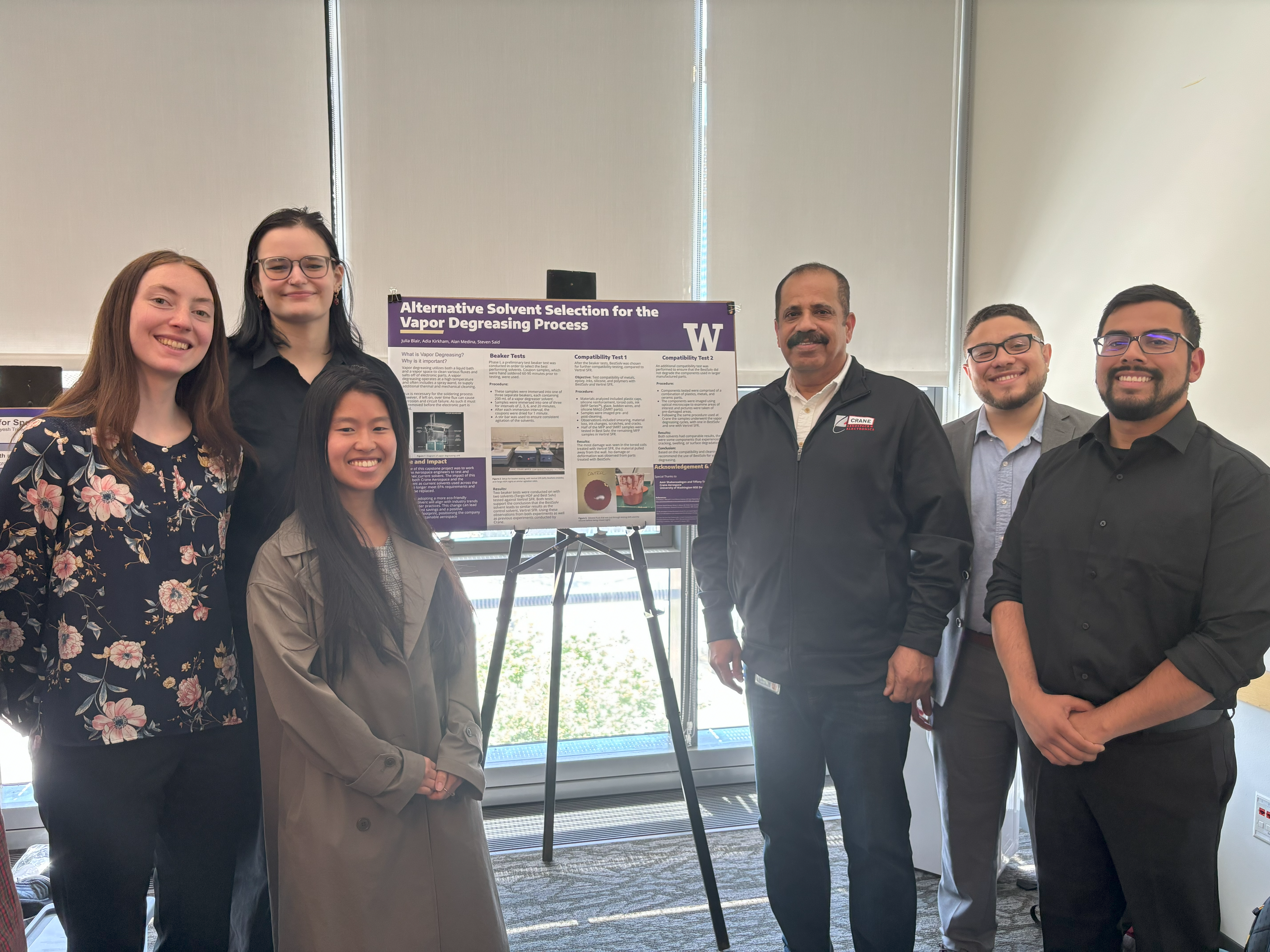
Crane Aerospace & Electronics
Vapor Degreaser Solvent Replacement
Chemours has announced they will be discontinuing the sale and production of Vertrel SFR. While Crane Aerospace & Electronics (CAE) has an immediate, short-term plan, a long-term replacement will need to be identified and validated. This student team will work to learn about the materials we need to clean, the components that a cleaning solvent needs to be compatible with, and perform material testing and validation to help CAE engineers find a path forward. This student team will work to perform a literature review on possible replacement materials, create a test plan, and carry out the test plan before determining the best replacement solvent. The students will have the opportunity to work alongside CAE engineers who will support and supervise the students as needed. The outcome this student team will work to achieve is a new cleaning solvent that is compatible with CAE's existing equipment and will pass both IPC and MIL-STD inspection requirements. The main purpose of this cleaning step/replacement solvent is to remove contaminates (fluxes, solder pastes, oils, greases, etc.) while not degrading what's already in the device (silicones, epoxies, component coatings, etc.). The life-cycle of this project is intended to run from literature review through material testing. This student team will need to take into account supply chain and ensure they make decisions early enough such that their testing timeline is not impacted. This student team will work to conduct preliminary tests at the UW Seattle campus, but CAE facilities in Lynnwood, WA can also be made available to support students' first runs so they are comfortable with their plan. Alternatively someone from CAE can support at UW's facilities. The outcomes this student team will work to achieve include: 1. Perform a literature review and market research to identify potential Vertrel SFR replacement solvents. 2. Down select to 2-3 solvents based on research and CAE requirements (cleanability and compatibility of materials and products) 3. Students to create a test plan to perform at UW to down select to 1 solvent 4. Students carry out test plan with help of CAE engineers 5. If time allows, students to run a validation test on CAE's equipment. 6. Students suggest a replacement solvent and the supporting data.
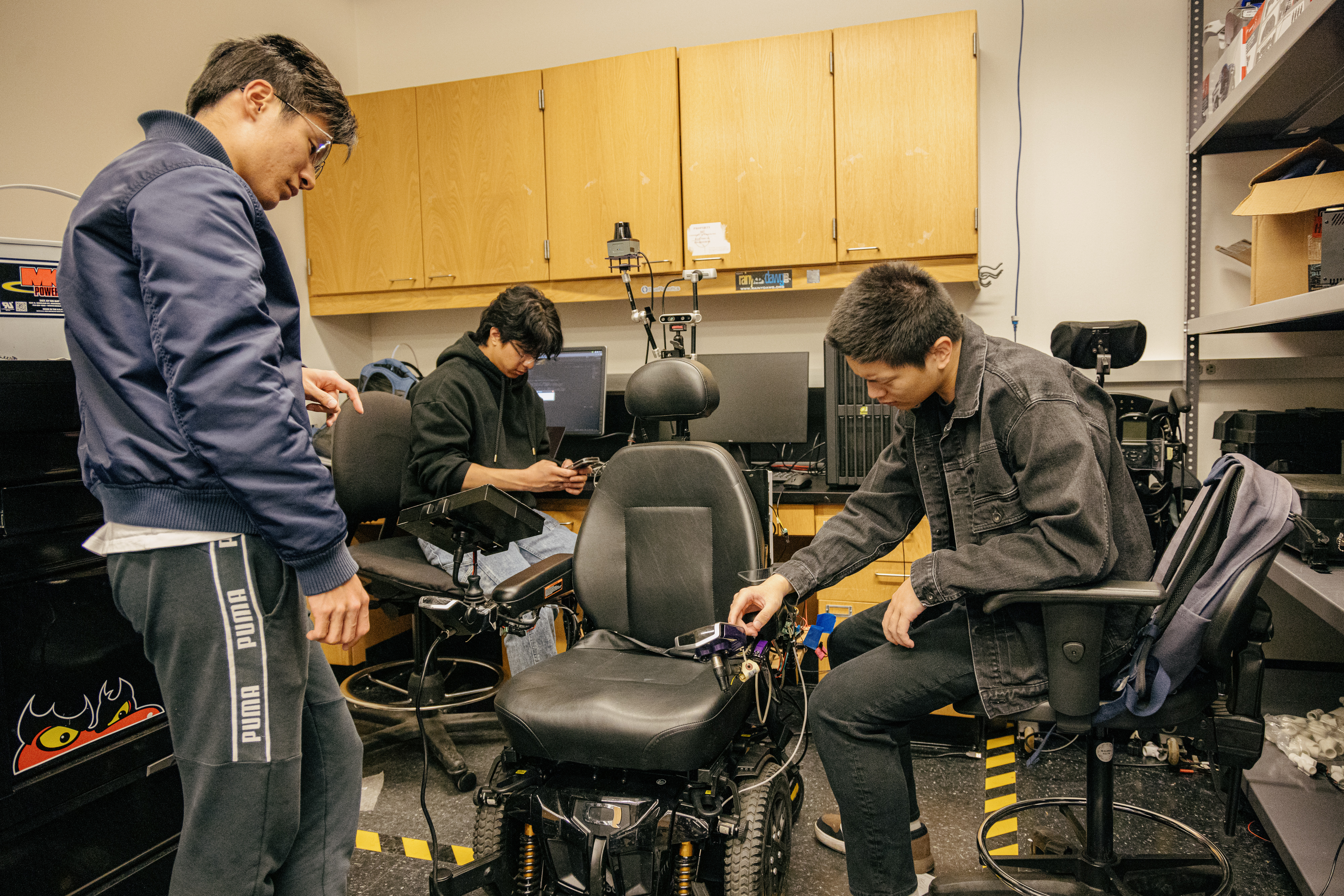
Cyberworks Robotics
Autonomous Self-Driving Wheelchair
Autonomous Wheelchairs increase freedom and ease of mobility for the most vulnerable people in society. Large Scale Campus Wide autonomous navigation of a power wheelchair faces numerous corner case confounds ranging from loss of localization due to feature sparsity to human motion sickness. This student team worked to identify and address corner cases that allow for robust persistent navigation over vast indoor and outdoor regions within the UW campus and fleet integration to the cloud for remote monitoring, user authentication, and over-the-air updates. Low hardware cost is essential to the mass adoption of such technology. Therefore, this student team worked to focus on the use of inexpensive but cutting-edge technologies such as monocular Neural SLAM and Dense Optical FlowML Behavior Cloning as a means to reduce or eliminate reliance on expensive LiDAR-based visual SLAM. Project design parameters and performance this student team will work to incorporate include: - Identification of navigational confounds in a complex large scale indoor/outdoor environment - AWS Robomaker cloud connectivity, monitoring, authentication and software management - Point Cloud Obstacle Cluster Velocity Tracking - Graceful Motion based Navigation (U Michigan papers) The outcome this student team will work to accomplish is a graceful robust autonomous wheelchair navigation in large scale real world environments at an affordable price using the Cyberworks Autonomous Navigation Stack.
Fluke
Magnetic Flux Correlation
This student team will work to improve the accuracy and reduce the cost of sensing electric current by characterizing magnetic pathways in real time using capacitance. This student team will work to involve correlating and characterizing physical gaps in electrically and magnetically conductive materials, where a gap in an electrically conductive material results in capacitance and a gap in a magnetically conductive material results in an air gap in the magnetic circuit. This student team will work to achieve these results through simulation, planning, designing and building a prototype system, performing experiments, and correlating electrical capacitance to magnetic circuit impacts. The student team will work to simulate magnetic flux and electrical capacitance. They will need materials that have high magnetic permeability (permalloy, mu-metal, Si steel, or similar) as well as magnetic flux sensors. The student team will also work to utilize electrical circuit components and circuit prototyping materials as well as work to develop a method for accurately measuring capacitance or changes in capacitance. The student team will work to develop a test structure (made of the materials listed above), which will likely require small precise positioning or assembly to create and maintain air gaps for experimentation. For this structure, the students could work to conduct 3D printing or to create a consistent setup with other non-conductive materials. The outcomes this student team will work to accomplish is a simulation model of the correlation of a magnetic air gap to an electrical capacitive spacing, as well as a graph or family of graphs relating magnetic air gap to capacitance. The student team will also work to provide a comparison of the simulation to experimental results, and will work to provide a listing and discussion of the variables that were found to affect the relationship, as well as a physical test setup and brief report summarizing findings.
FusionFlight
Precision DAQ Package for Aerospace Applications
The student team will work to develop a cost-effective microcontroller-based Data Acquisition (DAQ) system tailored for aerospace applications, with a primary focus on real-time data collection, onboard storage, and wireless streaming. The system should be integrated into a drone platform for simultaneous acquisition of GPS, inertial, stress, and strain data. The performance goals the student team will work toward include achieving > 1Hz GPS sampling rates, 50Hz IMU sensing, and 10Hz stress and strain testing. Through this project students will first work to conduct a focused review of the existing design. They will then work to develop a prototype capable of 1Hz GPS data capture and storage within 4-5 weeks, with experimental validation. Next, they will work to implement advanced wireless protocols for real-time data streaming. Finally, they will work to execute targeted validation tests. The key milestones this student team will work to achieve are: - System Design and Microcontroller Selection - Prototype Development and Sensor Integration (with the priority being to develop a prototype capable of 1Hz GPS data capture from 5 GPS sensors simultaneously and store to SD card.) - Integration of Additional Sensors and Onboard Storage - Integration of Wireless Streaming -Performance Testing and Calibration -Validation and Optimization (On Drone)

GE Vernova
AI/ML for Electric Distribution Grid Outage Analysis
GE VERNOVA's Advanced Distribution Management System (ADMS) includes a suite of applications designed to meet real-time management needs of electric distribution utilities. Fault location and outage assessment have long been an area of interest for electric utilities, who are aiming to find the failure locations as fast as possible to minimize the impact. AI/ML has been extensively researched to be used with real-time prediction of the location of faults. Archived fault location data when used with AI/ML has the potential to better forecast outages. Forecasting outages during extreme events, or even under normal conditions, provides a better understanding of the distribution grid and highlights vulnerable locations of the grid. This also provides opportunities for long term system planning as well as extra tools during extreme events. Current literature presents a range of AI/ML methods for outage forecasting, most consider every outage as a single point that is fed to the predictive model and output is usually a binary classification of the devices as impacted or operational. While this binary classification could be useful in certain instances, e.g., day ahead forecasting, they do not offer a deep knowledge of the system for long term planning or reliability and resiliency analysis of the system. This student team will work to develop a AI/ML application that can analyze/simulate using real-time data and meteorological information to predict grid outages. The application should provide a risk assessment of the network through indices, probabilities, or classification of the assets. The student team should also work to present and examine optimal visualization of the results. The student team can work to train the application with historical outage data as well as weather forecasting at the time of event. This student team can work to use archived data (actual data driven from real events), oversampled mixture of real data, or synthetic data generated by ADMS. The student team can also work to devise a preprocessing step to address data generation, data cleaning, normalization, and feature extraction. The student team should work to evaluate the well-suited approaches to the problem at every step of the way from data generation to results presentation.
Genmab
Building the Digital Mindset of the Future
Genmab is a fast growing biotech who prides itself on a data driven digitally enabled approach to science & our overall business. In order to achieve Genmab's lofty strategic goals, they need to embrace digital technology across the organization at all levels to deliver impactful results at scale. This student team will work to 1) identify ways to segment diverse populations on their level of digital intelligence and 2) create user journeys by segment and supporting resources. This student team will work to - conduct a SWOT analysis of the current digital mindset across Genmab - create custom surveys & interviews to assess digital literacy - create personas and a resource library or libraries - develop and deploy digital mindset learning modules - test and learn, iterate, and refine resources - use surveys/focus groups to assess current digital literacy across functions of the organization - analyze and segment personas into distinct groups This student team will work to create a digital mindset playbook via the following programmatic milestones: SWOT analysis of organization’s Digital Literacy 1/24 Research Findings: User surveys & focus groups 2/24 Resource creation for prioritized segments 3/24 Pilot Assessment: Test, Learn & Measure Impact 4/24 Digital Mindset Playbook 5/24
Genmab
Delivering Digital Transformation: Establishing a POD Operating Model
The purpose of this project is to enhance Genmab's Digital Delivery model by transitioning to a scalable, responsive Product-Oriented Design (POD) methodology. This student team will work to increase IT services project throughput, adaptability, and scalability. This student team will also work to optimize the adoption of Agile methodology. This student team will work to conduct an analysis of current processes and risk/benefits of proposed solutions across key measure (e.g., project throughput, speed-to-market, quality, resource utilization.) This student team will also work to identify key stakeholders and engagement plans. The student team will work to create a blueprint for optimized Agile adoption within the POD mod and to identify and deliver resources required for successful rollout of the refined Agile-POD model across multiple teams. Finally, this student team will work to transition IT solution implementation from Waterfall/ Hybrid to a scalable POD model. This student team will work to create and deliver a POD operating model playbook. This outcome will be accomplished through the following programmatic milestones: - POD Requirements, architecture, design 1/24 - Pitch Enhanced POD Model Pilot 2/24 - Model Implementation/Iteration 3/24 - Deliver POD Operating Model Playbook 5/24
Genmab
End-to-End (E2E) Customer Engagement
Historically an R&D company, Genmab recently added Commercial capabilities and has a 2030 vision of becoming one of the top ‘end-to-end biotechs’ in the industry. To achieve this, Genmab believes stakeholder management and coordinated customer engagement across various internal functions (e.g. medical, clinical, commercial) is essential. This student team will work to deliver seamless E2E experience for all customers, by establishing the processes, people, and technologies that increase coordination & streamline external engagement activities with Genmab's customers. This student team will help Genmab work to deliver a seamless end-to-end customer experience for all customers. This student team will work to assess current processes and stakeholders, review & refresh customer experience journeys, build a database of key stakeholders defined by role, expertise, and influence and conduct a solutions assessment resulting in the team’s recommendation. The student team will also work to automatize workflows triggering a next best action and prioritize data fields in data collection. The outcome this student team will work to achieve is a prototype algorithm (to recommend next best actions to take) that will be accomplished via the following milestones: - Customer Journey Review/Refresh -- 1/24 - SWOT analysis for current solutions -- 2/24 -Analogs for Customer Engagement Models -- 2/24 -Platform Recommendation & Pilot -- 3/24 - Prototype Algorithm (Next Best Action) - 5/24
Genmab
Leveraging AI to Identify the KOL of the Future
Key Opinion Leaders (KOLs) play a pivotal role in shaping the direction of medical research, clinical practice, and public awareness. Traditional methods for identifying KOLs fall short in identifying emerging voices or perspectives as well as limiting the inclusion of some minority populations. This student team will work to apply AI/Data Science techniques to identify “rising stars” whose expertise and influence are expected to have a significant impact on the future of medicine. This student team will work to acquire a thorough understanding of current KOL criteria. The student team will also work to collect data and conduct analysis from desperate sources. The student team will work to conduct influence mapping, as well as predictive modeling, and trend analysis. The student team will also work to consult experts, such as clinicians and pharma industry experts. The outcomes this student team is working to accomplish include a comparative analysis, web based user interface, and the creation and delivery of a AI KOL Finder Playbook.
Genmab
The Smartphone-Enabled Slit Lamp Device
This student team will work to design and build a novel, smartphone-connected slit lamp that enhances portability and usability while maintaining the high standards of examination precision required in ophthalmology. A more affordable, portable device will enable greater access to slit lamp exams, with particular benefit in more rural and low income areas of the globe. The student team will work to create a solution with the end user in mind, allowing for an intuitive and easy user experience. The student team will work to conceptualize and design a slit lamp that integrates with a Smartphone/Tablet. The optical precision should be comparable to existing Slit Lamp Devices and the slit lamp should have a user-friendly interface. The slit-lamp should be portable, affordable and durable. The student team will work to provide comprehensive documentation, including design schematics, user manuals, and technical specifications. The outcomes this student team is working toward is a prototype and end-to-end product demo of a more affordable, portable slit lamp device as well as a "how to" resource guide.

Group14
Design and Testing of Fluid Flow Through a Porous Particulate Bed
The student team will characterize fluid flow through a bed of porous particulate materials. Fluid flow has profound impacts upon many chemical processes important to nanofabrication such as filtration efficacy, chemical vapor deposition homogeneity, and catalyst utilization. The goal for the team is to develop a method and prototype apparatus for measuring pressure differentials across a bed of particles and test a variety of porosities, particle size distributions, bed depths and packing densities, and develop empirical trends for each variable. This project is relevant to both Materials Science and Chemical Engineering departments as it characterizes a material with different structures and processing conditions to understand a performance of a key property. The project parameters would involve both the experimental apparatus design and fabrication as well as the testing of various material and processing conditions. Performance will be judged on the ability to specify different conditions and materials in terms of pressure drop and the ability of the students to determine a basic empirical model / determine a maximum bed depth for a given allowable pressure drop and particle properties. The scope of the project is limited to examining effects on particle size distribution, particle porosity, particle packing and bed depth. This project allows students to engage in experimental apparatus design, method design, and data modeling which is applicable to future work in a wide variety of industries / careers as material science or chemical engineers. Desired outcome is the transfer of a test apparatus and an empirical model of the scoped process variables and pressure drop across a bed of material.
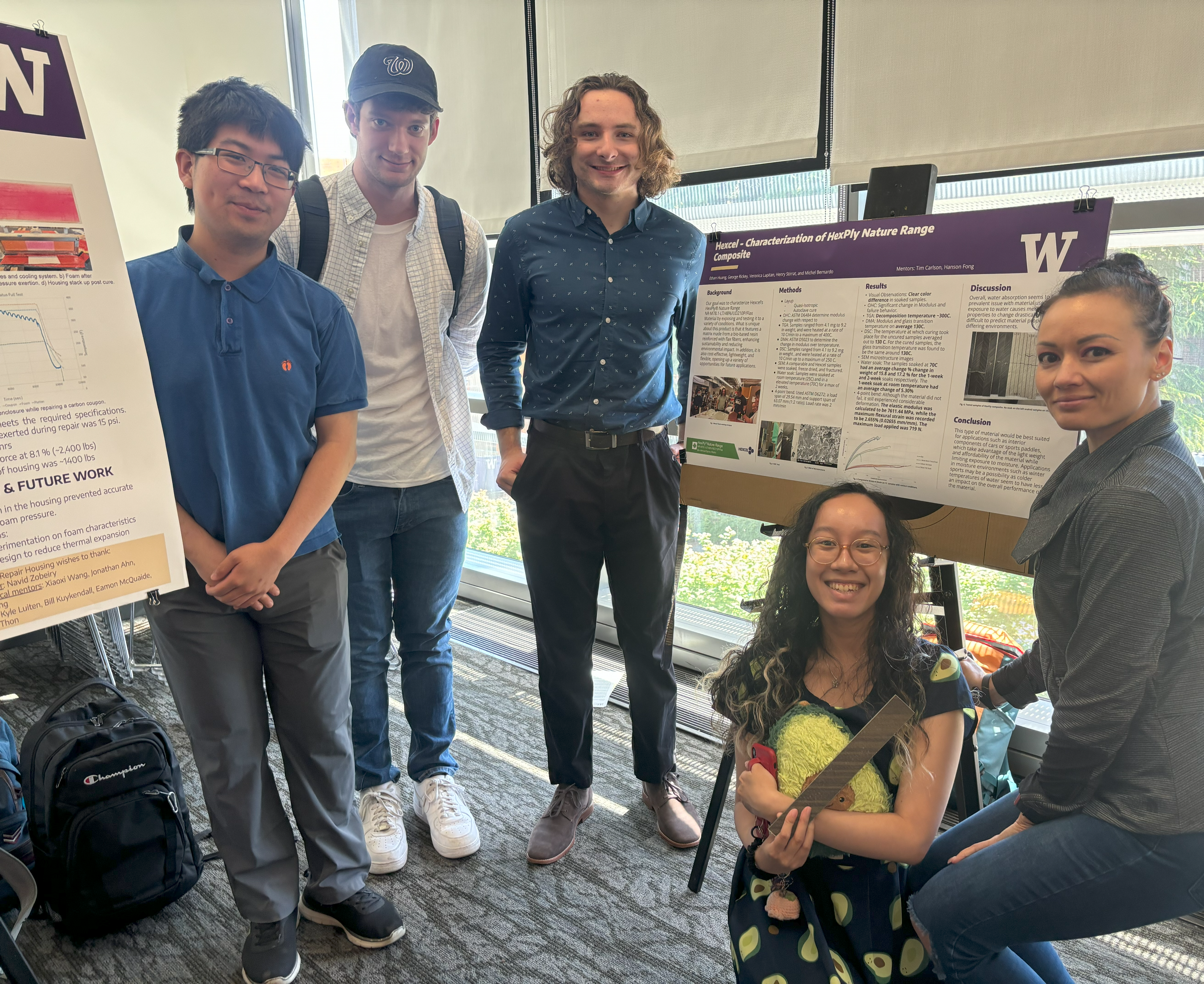
Hexcel
Strength and Workability of Environmental and Sustainable Hexcel Nature Range Composites
Hexcel has a line of sustainable bio-based materials - resins and fibers - that are relatively new to the market. They have not been readily available to the American market, rather mainly marketed in the EU as they are currently manufactured there. This means there is little experience with these materials in the American market. This student team will work to get hands on experience, fabricate samples, test those samples, evaluate its performance, and devise potential applications in the composite market. This student team will also work to produce a demonstrator part out of this Nature Line material. The students will provide valuable knowledge, data, and experience for Hexcel's R&T Kent lab and Hexcel as a whole. This student team will work to build enough test panels for impact, open hole compression, strain, tensile, and environmental cycling to test moisture absorption and effects on the results of the above mentioned tests. This student team will also work to design and complete a test method to evaluate material drapability and workability and provide an evaluation of the material. As a stretch goal, this student team qill work to delve into a processing comparison between oven and autoclave cured methods by completing panels, using micrographs to check for porosity, cracks, and other irregularities. Finally, this student team will work to build a demonstrator part, oven or autoclave cured to be determined by the team, and present their findings in the final report at the end of the capstone program. This student team will work to deliver results from all the material testing as well as a comparative study to existing incumbent materials in use. This student team will work to present a demonstrator made with the Nature Range materials, and present all findings along with pictures of setups, testing, micrograph results, lessons learned along the way, and recommended uses for this material. The general project development pathway this student team will work toward can be described as: Find a potential application, compare the Nature Line materials to existing products that are used for that application. Once a potential application is identified, determine the tests, make the panels, perform the tests, then make a demonstrator.
Related News

Fri, 09/20/2024 | UW Civil & Environmental Engineering
Smarter irrigation for a greener UW
A new project combines satellite data with ground sensors to conserve water and create a more sustainable campus environment.
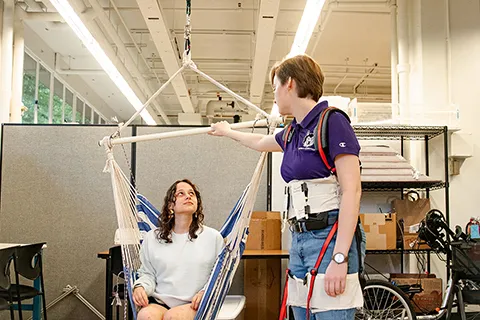
Mon, 09/09/2024 | UW Mechanical Engineering
Testing an in-home mobility system
Through innovative capstone projects, engineering students worked with community members on an adaptable mobility system.
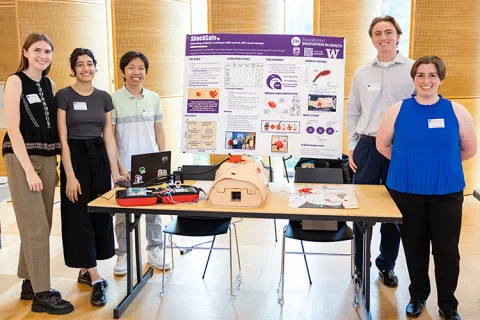
Mon, 08/19/2024 | UW Mechanical Engineering
Students strive to ensure accurate AED shock dosage
ShockSafe, developed by students with the help of mentors from Philips and Engineering Innovation in Health (EIH), can distinguish between children and adults during cardiac arrest emergencies.

Wed, 08/07/2024 | Snohomish County News
Snohomish County, University of Washington partnership boosts efficiency in enterprise scanning center
UW Industrial and Systems Engineering Capstone Project set to save Snohomish County over $40,000 annually.